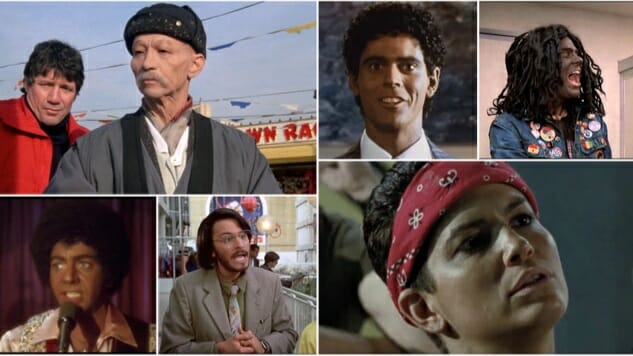A Tour of Cinematic Blackface, Brownface and Yellowface in the 1980s

Recently, it came to the public’s attention that so, so many politicians turned out to have worn blackface in the ’80s that the question now becomes which politician didn’t. On top of this, along comes Megyn “Santa is white” Kelly with her controversial—i.e., dumb and insensitive—comments about how blackface was not a big deal during that period, which supposedly contributed to her daytime talk show being cancelled. All of this got me wondering, was blackface not a big deal in the ’80s? Was it frowned upon and rightfully shamed the way it is now, or were performers pulling out the black make up and afro wig at every opportunity the way they did during the first half of the 20th Century?
The answer, as with many things in life, lies somewhere in between. The use of makeup for white actors to appear a different race was not as pervasive as it was during the “golden age of Hollywood.” Check out Bamboozled’s end montage for a sobering dose of that reality. But that doesn’t mean it wasn’t present. Of course just because the practice is used, doesn’t automatically make it offensive. To back that up, I have two magical words for you: Tropic Thunder. So in an effort to find nuance, let’s explore some of the uses of blackface, brownface and yellowface in ’80s movies (Spoiler: It’s mostly really, really bad.)
The Jazz Singer (1980)
Actor: Neil Diamond
Offense: Blackface
Most remakes will contain scenes or at least references to memorable moments from the original. In the case of this laughably miscalculated attempt at turning Neil Diamond into a movie star, the studio executives should have ignored one of the glaring elements that people remember from the 1927 original: Al Jolson in blackface. Of course the first Jazz Singer was primarily known for being the first major feature release with sound, but it’s hard to make that a big deal in 1980. So in the coked-up minds of the executives, the solution to provide a link between the two films was to blacken Neil Diamond up. In order to get with the times, they come up with the old, “I can’t be racist, I have black friends” defense, and plant a bunch of black musicians on the scene. The set-up is that Diamond’s struggling singer has to put on blackface because the club they’re playing at is looking for an all-black band. This effort to put a spin on the original actually makes things worse, since it makes it look like the blackface was the black characters’ idea, removing all responsibility from the white protagonist.
The Fiendish Plot of Fu Munchu (1980)
Actor: Peter Sellers
Offense: Yellowface
All I really need to make my case here is to share this clip. Reader be warned: This snippet is so unbelievably racist, that you might want to switch to Incognito Mode before clicking on the link. It would have been poetically apt to call Peter Sellers’ sublime turn in Being There his last performance before his death, if fate’s fiendish sense of humor didn’t intervene in the form of this bizarre heist comedy. Sellers has dual parts here, one of which is the title role, a 168-year-old supposedly charming and charismatic supervillain who leaves no appalling Asian stereotype unturned. The character, originated from a series of popular pulp novels, saw many white actors, from Boris Karloff to Christopher Lee, put on yellowface in film adaptations over the decades. Sellers’ equally terrible rendition has the distinction of being the latest, and hopefully the last.
The Year of Living Dangerously (1982)
Actor: Linda Hunt
Offense: Yellowface
This is by far the least offensive entry on the list. In director Peter Weir’s solid political thriller/exotic love story, white actress Linda Hunt plays a Chinese-Australian male diplomat who guides Mel Gibson’s reporter through Indonesia’s political turmoil. The character is three-dimensional, and is handled with dignity and individuality, without any discernible stereotypes. So much so that Hunt won that year’s Best Supporting Actress Oscar. The relationship between Hunt and Gibson establish the moral anchor of the story. Weir is also on record that he looked extensively for an Asian actor to play the part the way he wanted, but had to settle for Hunt. All of that being said, such a casting decision would likely result in widespread condemnation today, and for good reason. It just looks better by default, compared to all the other examples on this list.
Scarface (1983)
Actor: Al Pacino
Offense: Brownface
Just because it’s one of the most iconic performances in film history doesn’t change the fact that Italian actor Al Pacino has put on brownface and adopted the most cartoonish possible Cuban accent to portray ye-yo enthusiast/Miami drug kingpin Tony Montana. Brian De Palma’s physical manifestation of ’80s excess is so giddily over the top, and Pacino’s no-fucks-given masterclass in scene chewing is so singular, that it’s easy for the audience to cognitively disassociate Scarface’s protagonist from anything resembling a real person. Yet the character’s still supposed to be Cuban, and is still a live-action cartoon. Someday even the biggest hard-core fan might have to come to terms with this. From there, maybe we can move on to De Palma and Pacino doing pretty much the same thing with Carlito’s Way in the ’90s.
-

-

-

-

-

-

-

-

-

-

-

-

-

-

-

-

-

-

-

-

-

-

-

-

-

-

-

-

-

-

-

-

-

-

-

-

-

-

-

-








































